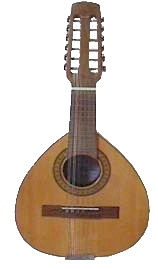
バンドゥリア
Bandurria

☆
バ
ンドゥリアはスペインの撥弦楽器で、マンドリンやバンドラに似ており、主にスペインの民族音楽で使われるが、スペインの旧植民地でも見られる。
| The bandurria is a
plucked chordophone from Spain, similar to the mandolin and bandola,
primarily used in Spanish folk music, but also found in former Spanish
colonies. |
バンドゥリアはスペインの撥弦楽器で、マンドリンやバンドラに似てお
り、主にスペインの民族音楽で使われるが、スペインの旧植民地でも見られる。 |
| Instrument development Prior to the 18th century, the bandurria had a round back, similar or related to the mandore.[1] It had become a flat-backed instrument by the 18th century, with five double courses of strings, tuned in fourths.[1] The original bandurrias of the Medieval period had three strings. During the Renaissance they gained a fourth string. During the Baroque period the bandurria had 10 strings (5 pairs). The modern bandurria has 12 strings (6 pairs). The strings are tuned in unison pairs, going up in fourths from the low G#. The lowest four strings are a major-third above those of a standard guitar and the highest two strings are a fourth above a standard guitar, i.e. G♯, c♯, f♯, b, e' and a'.[2] |
楽器の発展 18世紀以前のバンドゥーリアは、マンドールに類似または関連した丸い背を持つ楽器であった[1]。18世紀には平らな背を持つ楽器となり、4分の4拍子 で調弦された5つのダブル・コースの弦を持つようになった[1]。中世時代のオリジナルのバンドゥーリアは3弦であった。ルネサンス期には4弦が追加され た。バロック時代のバンドゥリアは10弦(5対)であった。 現代のバンドゥリアは12弦(6対)である。弦はユニゾンのペアで調弦され、低いG#から4分の1ずつ上がっていく。最も低い4弦は標準的なギターの長3 分の1、最も高い2弦は標準的なギターの4分の1、すなわちG♯、c♯、f♯、b、e'、a'である[2]。 |
| Variations and uses in different
parts of the world Spain  Spanish Students in New York 1880 The Spanish Students, who were first brought to the United States by Henry Eugene Abbey's firm in 1880.[3] They played bandurrias, but confusion in the United States led people to believe the instruments were mandolins.[4] This poster was for a Manhattan performance at the Booth's Theatre on the corner of 6th Avenue and 23rd Street in Manhattan. 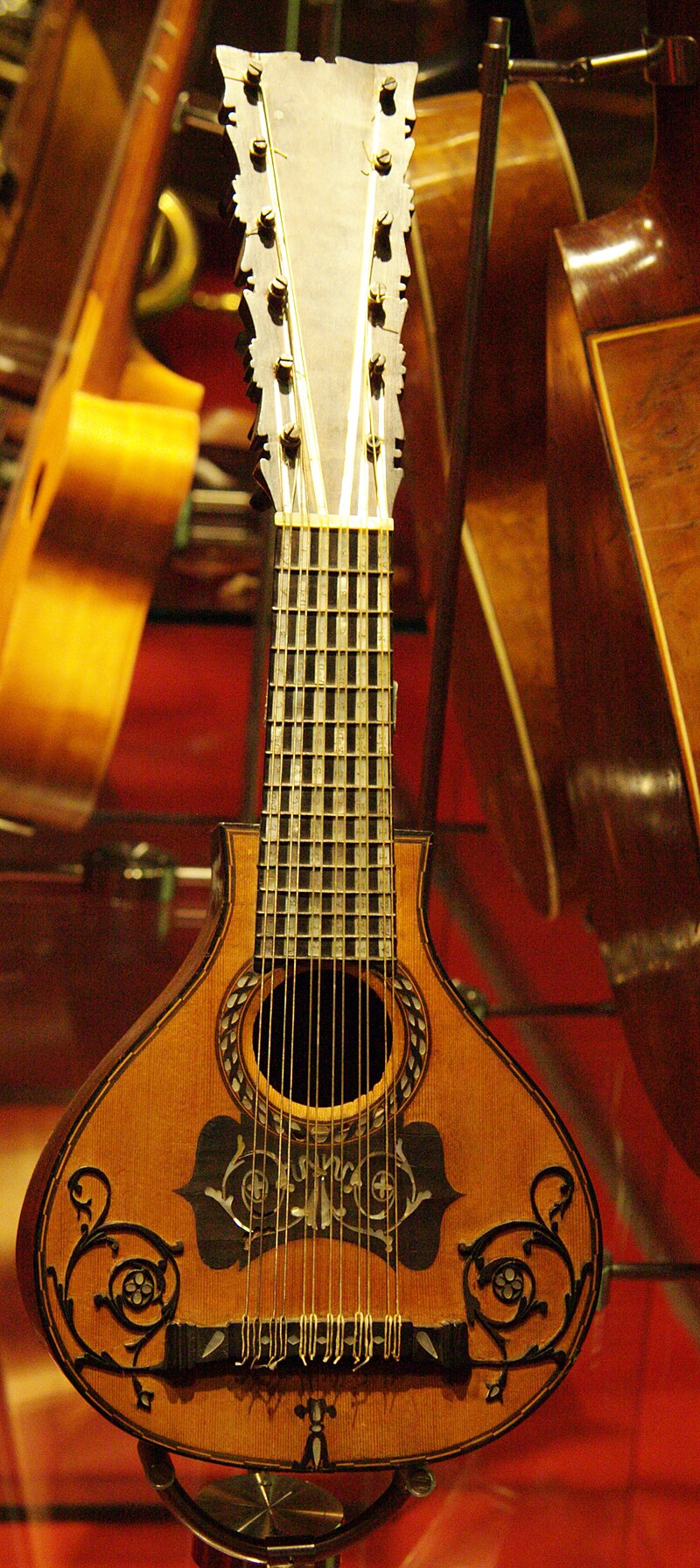 Bandurria with square shoulders Bandurria with square shoulders, Museum of Music, Barcelona. 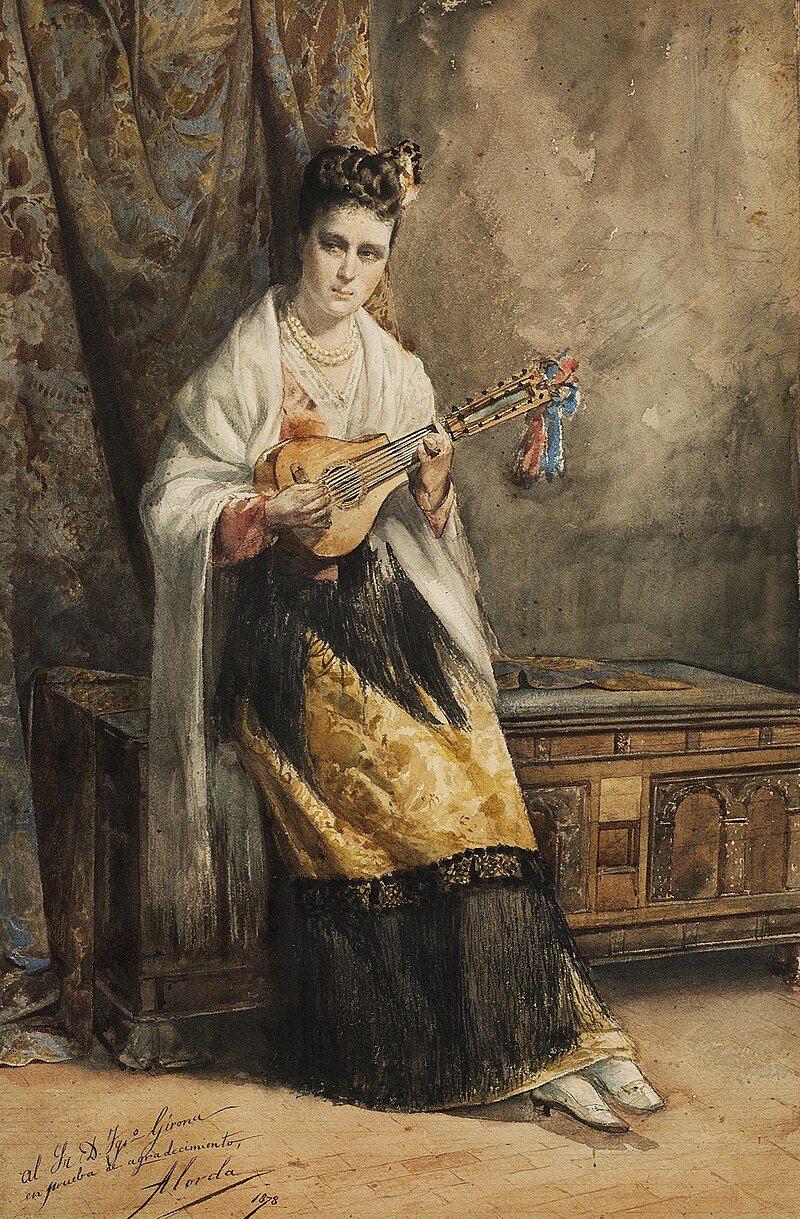 1878 Ramon Alorda Pérez painting, Woman with bandurria Painting by Ramon Alorda Pérez, 1878, showing a woman playing a bandurria that has square shoulders. The square-shouldered bandurria was a distinct shape of Spanish bandurrias of the 18th century.[5] Juan Ruiz first mentioned the term "mandurria" in the 14th century in his "Libro De Buen Amor." [6] After that, Juan Bermudo gave the description of the bandurria in his "Comiença el libro llamado declaraciõ de instrumentos" as a three-string instrument in 1555, but he also mentioned other types with four or even five strings. In the early 1870s, a child's wake was accompanied with the bandurria music in Jijona, Alicante Province. The zapateo, a dance derived from the Spanish zapateado and introduced by tobacco cultivators from the Canary Islands, is accompanied with bandurria and other instruments before 1900. |
世界各地での異なる使用法 スペイン  1880年ニューヨークのスパニッシュ・スチューデンツ 1880年、ヘンリー・ユージン・アビーの事務所によって初めてアメリカに持ち込まれたスパニッシュ・スチューデンツ[3]。彼らはバンドゥリアを演奏し たが、アメリカでの混乱により、人々はこの楽器をマンドリンだと思い込んでしまった[4]。 このポスターは、マンハッタンの6番街と23丁目の角にあるブース・シアターで行われたマンハッタン公演のもの。  四角い肩のバンドゥリア 四角い肩のバンドゥリア、バルセロナ音楽博物館。  1878年、ラモン・アロルダ・ペレスの絵画、バンドゥリアを持つ女性 ラモン・アロルダ・ペレスの絵画、1878年、肩が四角いバンドゥリアを演奏する女性が描かれている。四角い肩のバンドゥリアは、18世紀のスペインのバ ンドゥリアの特徴的な形であった[5]。 14世紀にフアン・ルイスが 「Libro De Buen Amor 」の中で初めて「マンドゥリア」という用語に言及した。[その後、フアン・ベルムードが1555年に出版した 「Comiença el libro llamado declaraciõ de instrumentos 」の中で、バンドゥリアは3弦の楽器であると記述しているが、4弦や5弦の楽器についても言及している。1870年代初頭、アリカンテ県ヒホナでは、子供 の通夜にバンドゥリアが演奏された。1900年以前には、スペイン語のサパテアード(zapateado)に由来し、カナリア諸島からタバコ栽培農民が持 ち込んだダンス、サパテオ(zapateo)が、バンドゥリアや他の楽器の伴奏で踊られている。 |
| Philippines The Philippine harp bandurria is a 14-string bandurria used in many Philippine folkloric songs, with 16 frets and a shorter neck than the 12-string bandurria.[2] This instrument most likely evolved in the Philippines during the Spanish period, from 1521 to 1898. The Filipino bandurria (also banduriya[7]) is used in an orchestra of plucked string instruments called rondalla. It is tuned a step lower than the Spanish version, that is, low to high: F# B E A D G.[8] Filipino bandurrias have been made with coconuts,[9] and as banjoleles with banjo bodies and goatskin soundboards. South America 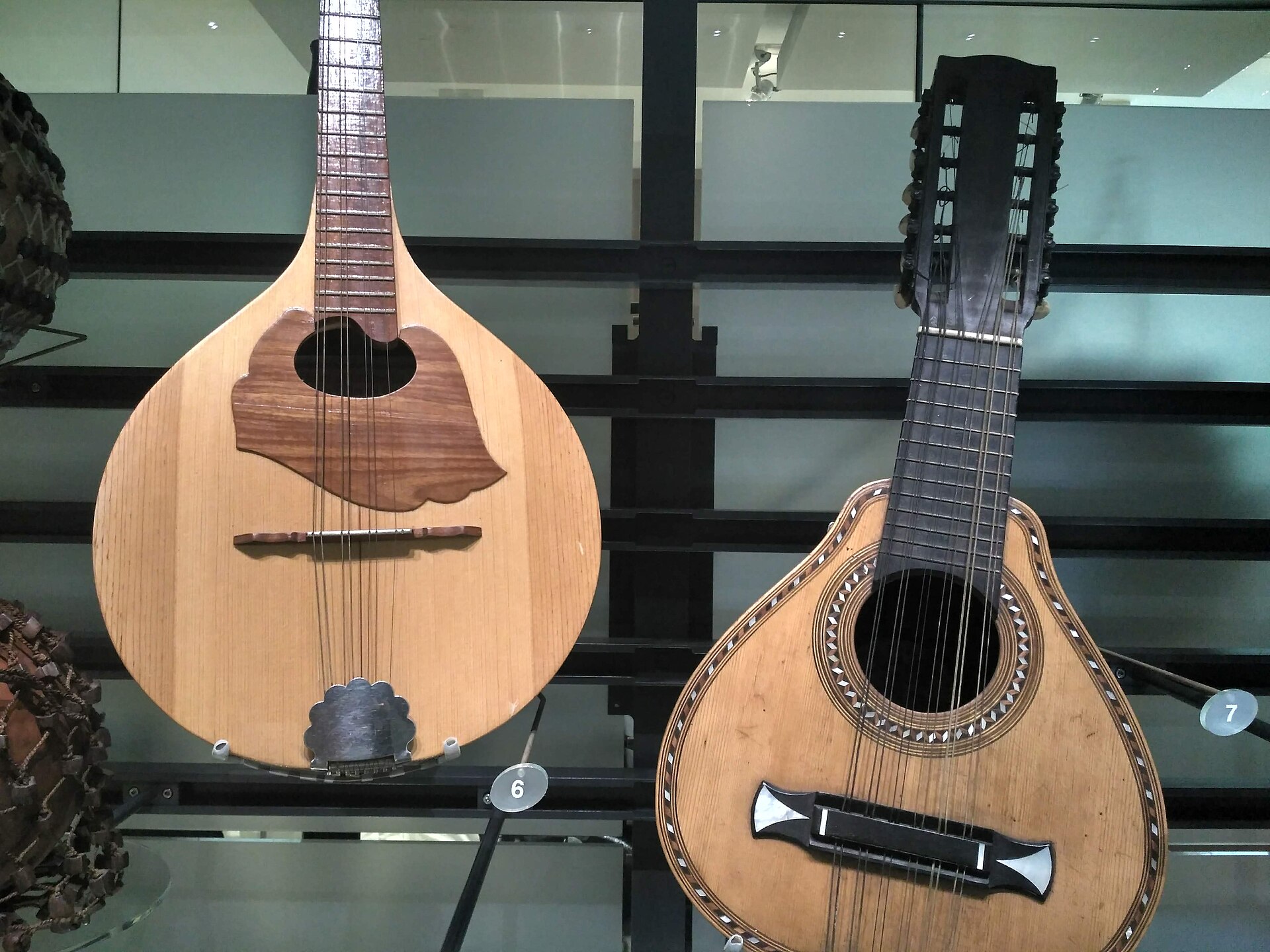 Bandurria (right) with mandolin in the Horniman museum, London, UK. There are also many different varieties of bandurria in South America, especially Peru and Bolivia. They have four courses, unlike the traditional Spanish six courses.[2] The four courses are double, triple or quadruple, and the tuning is guitar-like, rather than the fourths tuning used on the Spanish type.[10] In Lima, Peru, harp and bandurria duos were common in the early 20th century. Nowadays people there still play bandurria accompanying with the popular vals peruano, or vals criollo.[6] United Kingdom Although generally little known in the UK, the bandurria was used by Roy Williamson of the Scottish folk-group The Corrie Folk Trio. When this group later (after the loss of one member) became The Corries, Williamson incorporated a bandurria into one of the two multi-instrument "combolins" that he constructed for himself and his partner. |
フィリピン フィリピンのハープ・バンドゥリアは、フィリピンの多くの民謡で使われる14弦のバンドゥリアで、16フレットを持ち、12弦のバンドゥリアよりもネック が短い[2]。この楽器は1521年から1898年までのスペイン統治時代にフィリピンで発展した可能性が高い。フィリピンのバンドゥリア(バンドゥリヤ [7]とも呼ばれる)は、ロンダーラと呼ばれる撥弦楽器のオーケストラで使用される。スペイン語版より一段階低く、つまり低音から高音に調弦される: フィリピンのバンドゥリアはココナッツで作られたり[9]、バンジョーのボディとヤギの皮の響板を使ったバンジョーレとして作られたりしている。 南米  イギリス、ロンドンのホーニマン博物館に展示されているマンドリン付きバンドゥリア(右)。 南米、特にペルーとボリビアには多くの異なる種類のバンドゥリアもある。伝統的なスペインの6つのコースとは異なり、4つのコースがある[2]。4つの コースはダブル、トリプル、またはクアドラプルであり、チューニングはスペインのタイプで使用される4分音符ではなく、ギターのようである[10]。ペ ルーのリマでは、20世紀初頭にはハープとバンドゥリアのデュオが一般的であった。現在でも同地の人々は、ポピュラーなバルス・ペルアーノやバルス・クリ オーロの伴奏でバンドゥリアを演奏している[6]。 イギリス イギリスでは一般的にあまり知られていないが、バンドゥリアはスコットランドのフォーク・グループ、コリー・フォーク・トリオのロイ・ウィリアムソンに よって使用されていた。このグループが後に(メンバーを1人失った後に)ザ・コリーズとなったとき、ウィリアムソンは、自分とパートナーのために作った2 台のマルチ楽器「コンボリン」のうちの1台にバンドゥリアを組み込んだ。 |
| Notable players and music Javier Mas "Tamiz".[11] Rick Walker, a British musician, played this instrument on the song 'A Twilight Zone' by the artist Aim. |
著名な選手と音楽 ハビエル・マス「タミズ」[11]。 イギリスのミュージシャン、リック・ウォーカーは、アーティストAimの楽曲「A Twilight Zone」でこの楽器を演奏している。 |
| Rondalla Laúd Octavina Music in the Philippines Music of Peru Music of Spain Stringed instrument tunings |
ロンダラ ラウド オクタヴィーナ フィリピンの音楽 ペルーの音楽 スペインの音楽 弦楽器のチューニング |
| https://en.wikipedia.org/wiki/Bandurria |
|
| バンドゥリア(Bandurria)
はスペインの撥弦楽器の一種で、スペインの楽器、ラウド(英語圏では「リュート」、Laúd)と同じ種類に属する。歴史的には、Valentín
Hernándezが「バンドゥリアの父」と言われ、その起源はギリシャの古楽器、パンドラ (pandura,
Πανδούρα、語源的にギリシャ神話に関連すると推測される)と考えられている。パンドラは、紀元前6世紀ごろから使用された全音・半音を演奏するこ
とのできる弦楽器として演奏され、古代ギリシャのミケーネ文明期には存在しており、ラウド、バンドゥリアといった現代においても演奏される楽器にまで発展
した。後世において、ソプラノ・バンドゥリア、コントラルト・バンドゥリア、テノール・バンドゥリア、バス・バンドゥリアとコントラバス・バンドゥリアが
登場したが、現在はソプラノ、コントラルト、テノールが主に楽器として使用されている。テノール・バンドゥリアはバロック音楽を想起させる音色がラウドと
似ていることから、ラウドと混同されることも多いが、実際にはラウドとテノール・バンドゥリアはまったく別の楽器である。2つの楽器は形も似ているといわ
れるが、テノール・バンドゥリアの方が首が短く本体の部分が丸みをおびた形をしている。形状もギターのように底部は平坦で、特にバロック時代に使われたラ
ウドとは異なる。 |
|
| 特徴 鼈甲で弦をはじいて音を出す形式で演奏されていたが、現在は主にプラスチック製のピックが用いられている。 音の響き方に応じて、奏者の好みのピックを用いるのが一般的であるが、現在、もっとも使用されているのは涙型に近い三角形のものである。 弦は12本あり、鉄製の2本の弦の2組と、糸を用いて作られた2本の弦の4組で構成されている。後者は芯として鉄線やナイロン(一般的にギターに用いられる)が使用される。 一般的に、調弦は6つすべて弦のセット、A-E-F#-C#-G#の音において行う。 合唱や大衆音楽において演奏されることが多く、スペインの大学におけるトゥナや弦楽楽団においてはおなじみとなっている楽器である。 バンドゥリアは大衆向けの音楽で演奏される楽器と考えられる一方で、近年においては、ムルシア高等音楽学校等、音楽を専門としたスペインの高等教育機関においてバンドゥリアの演奏方法の指導も行われている。 |
|
| 歴史 バンドゥリアが具体的に楽器として存在したという歴史的な記録は、5世紀ごろの遺跡で確認することができる。上述のように、ミケーネ文明期に使用されていたパンドラから派生し、青銅器時代を通じて演奏されていたとされる。また、バビロニア文明期にはエジプトにも普及した。 古代ローマ人がこの楽器を多く取り入れたことにより南欧に普及し、アラブ文化、ベルベル人の文化との接触を経て現代の形に発展していったと考えられる。 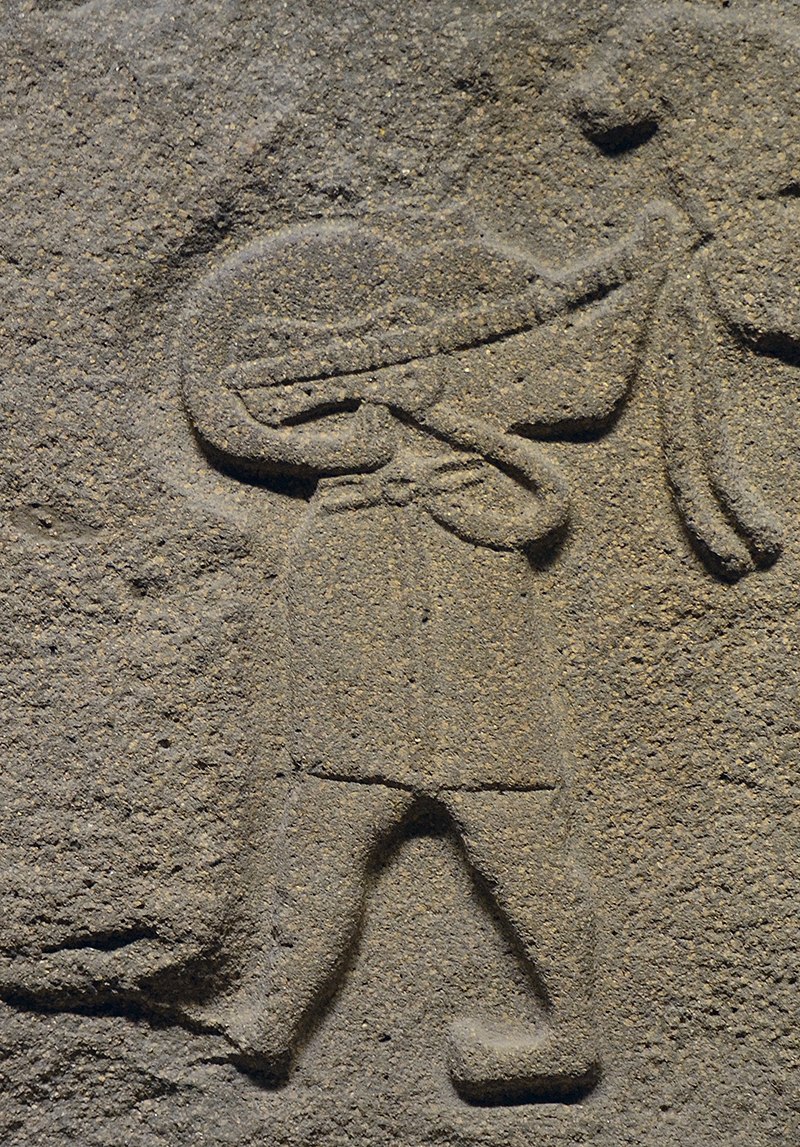 古代ギリシャのパンドラ さらに、大航海時代にはカリブ地域にまで普及しペルー、チリといった南米の国々でも使用されるようになった。中南米の国々ではキューバン・ラウドやバンド ラといった楽器に形を変えて発展をつづけた。また、バンドゥリアは、スペイン文化の一部としてフィリピン諸島の文化にも影響を与えた。 楽器の形としては、最初は3本の弦しかなかったが、それが18世紀には2本の弦の5セットという形に発展をした。その形に低音部の2本の弦の1セットを加えたのが現在のように2本の弦の6セットという形になった。さらに19世紀を通じて改良がくわえられ現在の形となった。 |
|
| https://x.gd/YPSPa |
Macho
Orccopi, Ccaccasiripi; sirenita/Maestro de Bandurria de Oro, Marcelino
Fernandez
リ ンク
文 献
そ の他の情報
CC
Copyleft,
CC, Mitzub'ixi Quq Chi'j, 1996-2099